2001 BMW 330i TOURING Car care
[x] Cancel search: Car carePage 165 of 203
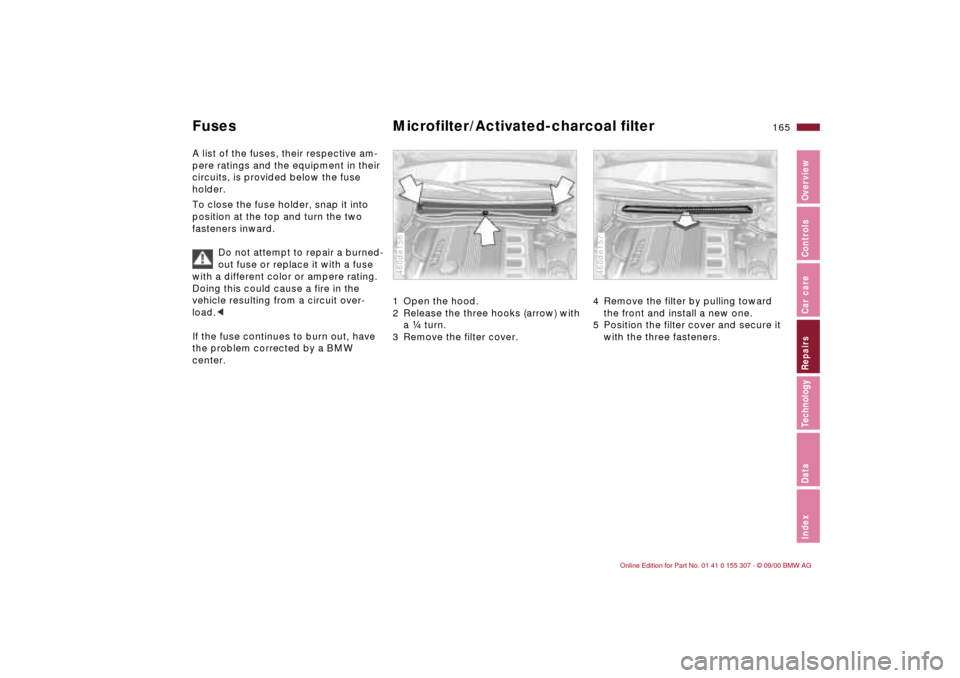
165n
IndexDataTechnologyRepairsCar careControlsOverview
Fuses Microfilter/Activated-charcoal filterA list of the fuses, their respective am-
pere ratings and the equipment in their
circuits, is provided below the fuse
holder.
To close the fuse holder, snap it into
position at the top and turn the two
fasteners inward.
Do not attempt to repair a burned-
out fuse or replace it with a fuse
with a different color or ampere rating.
Doing this could cause a fire in the
vehicle resulting from a circuit over-
load.<
If the fuse continues to burn out, have
the problem corrected by a BMW
center.
1 Open the hood.
2 Release the three hooks (arrow) with
a f turn.
3 Remove the filter cover.460de156
4 Remove the filter by pulling toward
the front and install a new one.
5 Position the filter cover and secure it
with the three fasteners.460de157
Page 167 of 203
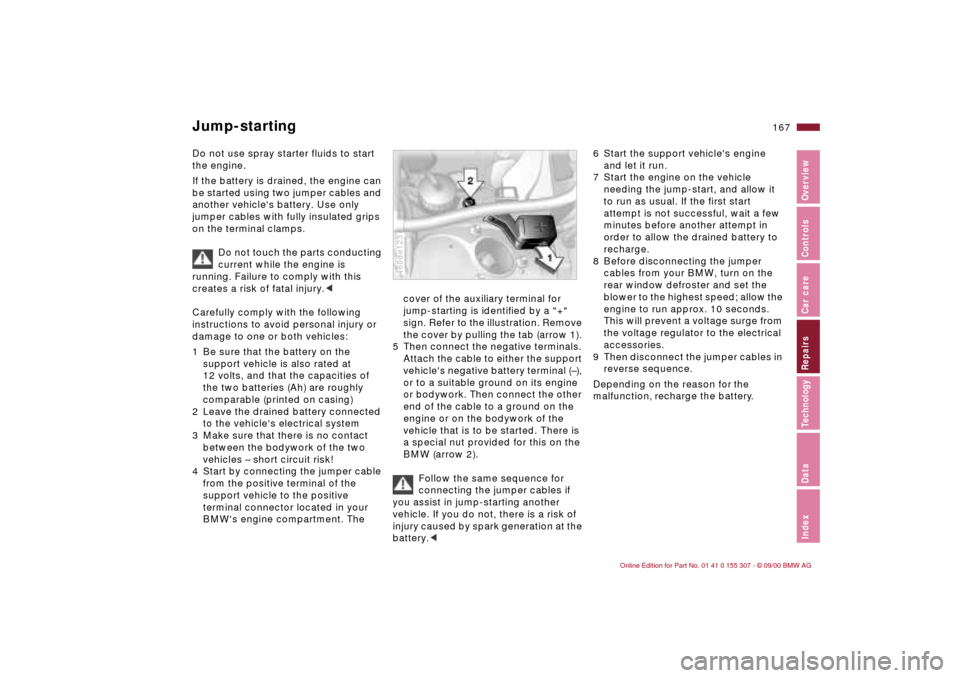
167n
IndexDataTechnologyRepairsCar careControlsOverview
Do not use spray starter fluids to start
the engine.
If the battery is drained, the engine can
be started using two jumper cables and
another vehicle's battery. Use only
jumper cables with fully insulated grips
on the terminal clamps.
Do not touch the parts conducting
current while the engine is
running. Failure to comply with this
creates a risk of fatal injury.<
Carefully comply with the following
instructions to avoid personal injury or
damage to one or both vehicles:
1 Be sure that the battery on the
support vehicle is also rated at
12 volts, and that the capacities of
the two batteries (Ah) are roughly
comparable (printed on casing)
2 Leave the drained battery connected
to the vehicle's electrical system
3 Make sure that there is no contact
between the bodywork of the two
vehicles Ð short circuit risk!
4 Start by connecting the jumper cable
from the positive terminal of the
support vehicle to the positive
terminal connector located in your
BMW's engine compartment. The
cover of the auxiliary terminal for
jump-starting is identified by a "+"
sign. Refer to the illustration. Remove
the cover by pulling the tab (arrow 1).
5 Then connect the negative terminals.
Attach the cable to either the support
vehicle's negative battery terminal (Ð),
or to a suitable ground on its engine
or bodywork. Then connect the other
end of the cable to a ground on the
engine or on the bodywork of the
vehicle that is to be started. There is
a special nut provided for this on the
BMW (arrow 2).
Follow the same sequence for
connecting the jumper cables if
you assist in jump-starting another
vehicle. If you do not, there is a risk of
injury caused by spark generation at the
battery.<460de123
6 Start the support vehicle's engine
and let it run.
7 Start the engine on the vehicle
needing the jump-start, and allow it
to run as usual. If the first start
attempt is not successful, wait a few
minutes before another attempt in
order to allow the drained battery to
recharge.
8 Before disconnecting the jumper
cables from your BMW, turn on the
rear window defroster and set the
blower to the highest speed; allow the
engine to run approx. 10 seconds.
This will prevent a voltage surge from
the voltage regulator to the electrical
accessories.
9 Then disconnect the jumper cables in
reverse sequence.
Depending on the reason for the
malfunction, recharge the battery.
Jump-starting
Page 169 of 203
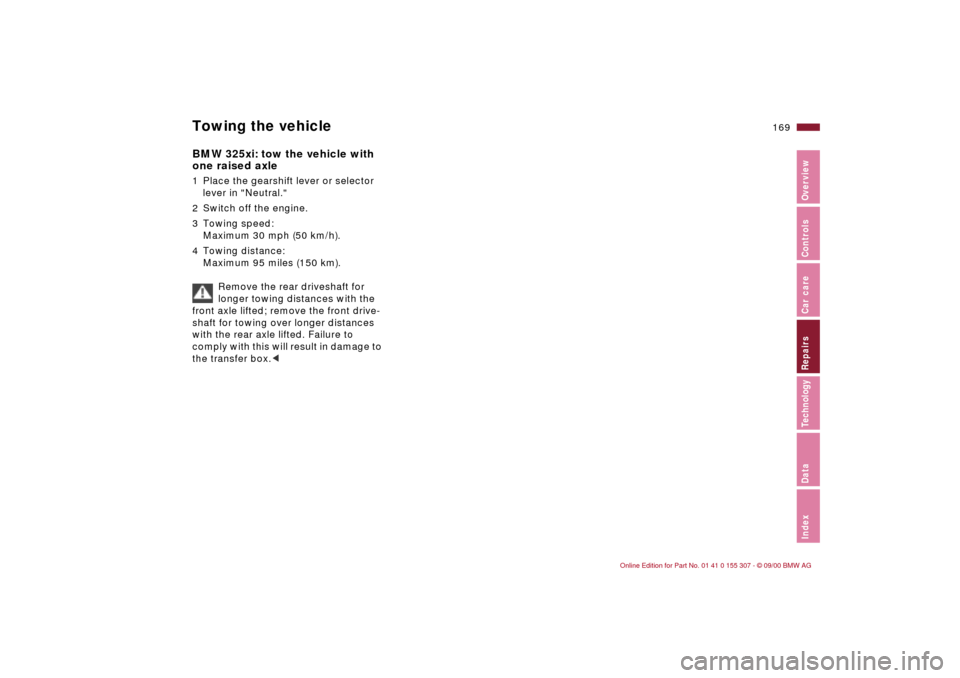
169n
IndexDataTechnologyRepairsCar careControlsOverview
Towing the vehicleBMW 325xi: tow the vehicle with
one raised axle1 Place the gearshift lever or selector
lever in "Neutral."
2 Switch off the engine.
3 Towing speed:
Maximum 30 mph (50 km/h).
4 Towing distance:
Maximum 95 miles (150 km).
Remove the rear driveshaft for
longer towing distances with the
front axle lifted; remove the front drive-
shaft for towing over longer distances
with the rear axle lifted. Failure to
comply with this will result in damage to
the transfer box.<
Page 171 of 203
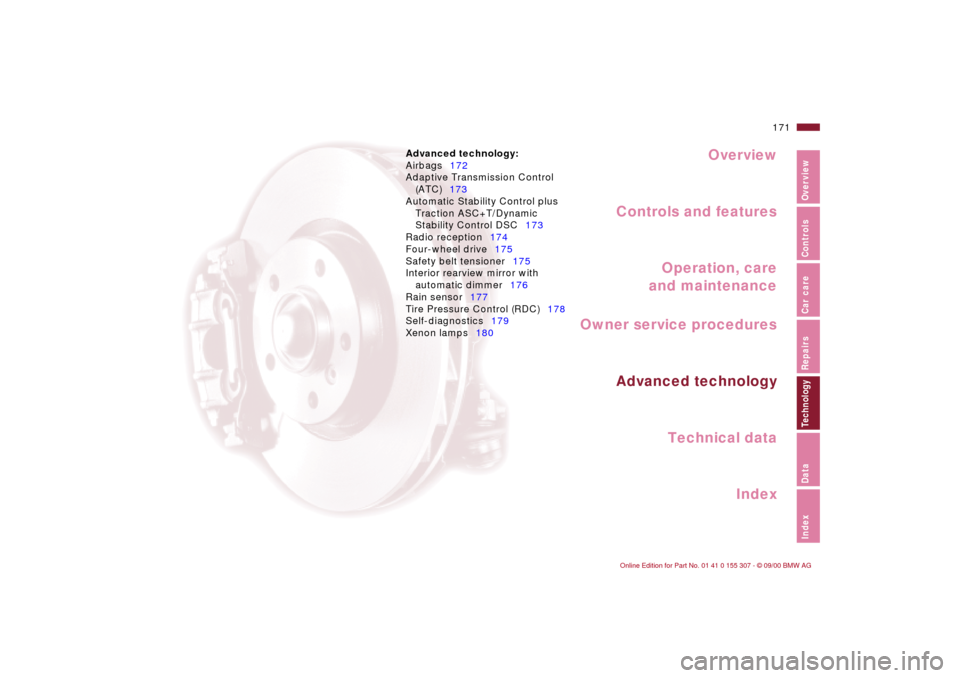
Overview
Controls and features
Operation, care
and maintenance
Owner service procedures
Technical data
Index Advanced technology
171n
IndexDataTechnologyRepairsCar careControlsOverview
Advanced technology:
Airbags172
Adaptive Transmission Control
(ATC)173
Automatic Stability Control plus
Traction ASC+T/Dynamic
Stability Control DSC173
Radio reception174
Four-wheel drive175
Safety belt tensioner175
Interior rearview mirror with
automatic dimmer176
Rain sensor177
Tire Pressure Control (RDC)178
Self-diagnostics179
Xenon lamps180
Technol-
Page 173 of 203
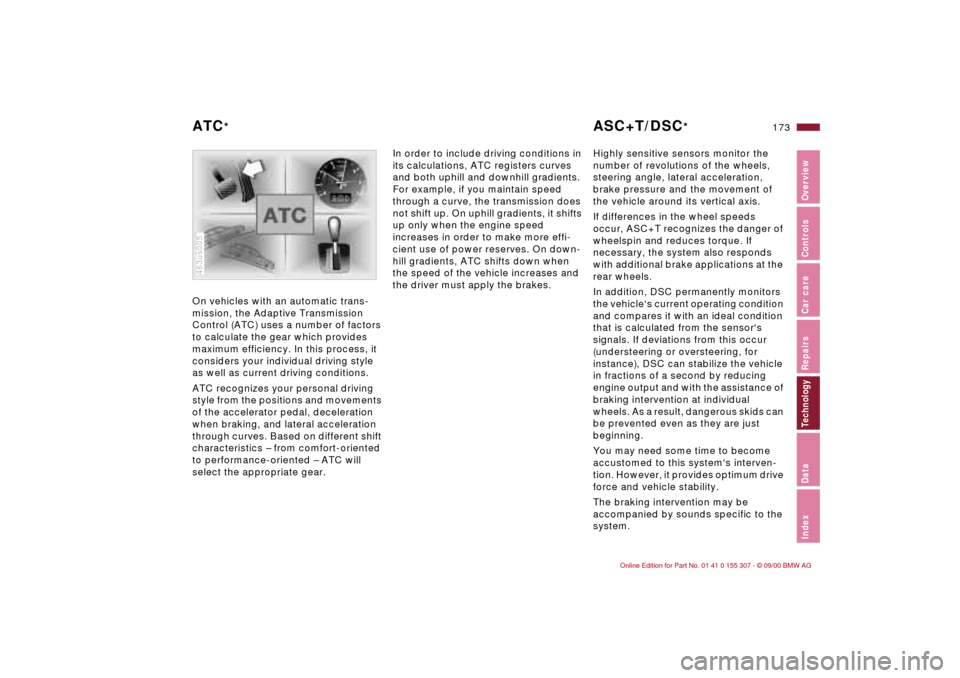
173n
IndexDataTechnologyRepairsCar careControlsOverview
On vehicles with an automatic trans-
mission, the Adaptive Transmission
Control (ATC) uses a number of factors
to calculate the gear which provides
maximum efficiency. In this process, it
considers your individual driving style
as well as current driving conditions.
ATC recognizes your personal driving
style from the positions and movements
of the accelerator pedal, deceleration
when braking, and lateral acceleration
through curves. Based on different shift
characteristics Ð from comfort-oriented
to performance-oriented Ð ATC will
select the appropriate gear.463us005
In order to include driving conditions in
its calculations, ATC registers curves
and both uphill and downhill gradients.
For example, if you maintain speed
through a curve, the transmission does
not shift up. On uphill gradients, it shifts
up only when the engine speed
increases in order to make more effi-
cient use of power reserves. On down-
hill gradients, ATC shifts down when
the speed of the vehicle increases and
the driver must apply the brakes.Highly sensitive sensors monitor the
number of revolutions of the wheels,
steering angle, lateral acceleration,
brake pressure and the movement of
the vehicle around its vertical axis.
If differences in the wheel speeds
occur, ASC+T recognizes the danger of
wheelspin and reduces torque. If
necessary, the system also responds
with additional brake applications at the
rear wheels.
In addition, DSC permanently monitors
the vehicle's current operating condition
and compares it with an ideal condition
that is calculated from the sensor's
signals. If deviations from this occur
(understeering or oversteering, for
instance), DSC can stabilize the vehicle
in fractions of a second by reducing
engine output and with the assistance of
braking intervention at individual
wheels. As a result, dangerous skids can
be prevented even as they are just
beginning.
You may need some time to become
accustomed to this system's interven-
tion. However, it provides optimum drive
force and vehicle stability.
The braking intervention may be
accompanied by sounds specific to the
system.
ATC
*
ASC+T/DSC
*
Page 175 of 203

175n
IndexDataTechnologyRepairsCar careControlsOverview
Four-wheel drive Safety belt tensionerThe transmission of power to the four
drive wheels is provided permanently
through a transfer box. The distribution
of torque between the front and rear
axles is 38% to 62%.
Traditional differential locks at the front
and rear axles and in the transfer box
are not required. Their function is
assumed by automatic braking inter-
vention at all four wheels. These trac-
tion interventions are governed by
Automatic Differential Brake (ADB-X), a
sub-function of DSC.
If a wheel tends to slip, it is braked
automatically by ADB-X until it once
again gains traction, and drive force
can be transmitted to that wheel. In
addition, the drive force is distributed to
the remaining wheels during this 530us133
system intervention. Engine output is
also reduced if necessary.
When the DSC is deactivated, the
ADB-X traction intervention is set for
the maximum drive force. However, the
engine intervention and the stability
controls are no longer available. For
this reason, DSC should only be deacti-
vated in the exceptional circumstances
described on page 81.
The BMW 325xi is not an off-road
vehicle. Instead, permanent four-wheel
drive provides a high degree of vehicle
stability and tractive ability under all
road conditions, and will aid you in crit-
ical driving situations, e. g. driving in
extreme winter conditions or on loose
road surfaces.The safety belt tensioner responds to
severe frontal collisions by tightening
the belts to ensure that occupants
remain firmly positioned in their seats.
A gas-pressure system retracts the
buckle assembly to tension the
shoulder and lap belts within fractions
of a second. This reduces the tendency
to slide under the lap belt.
390de330
Page 177 of 203
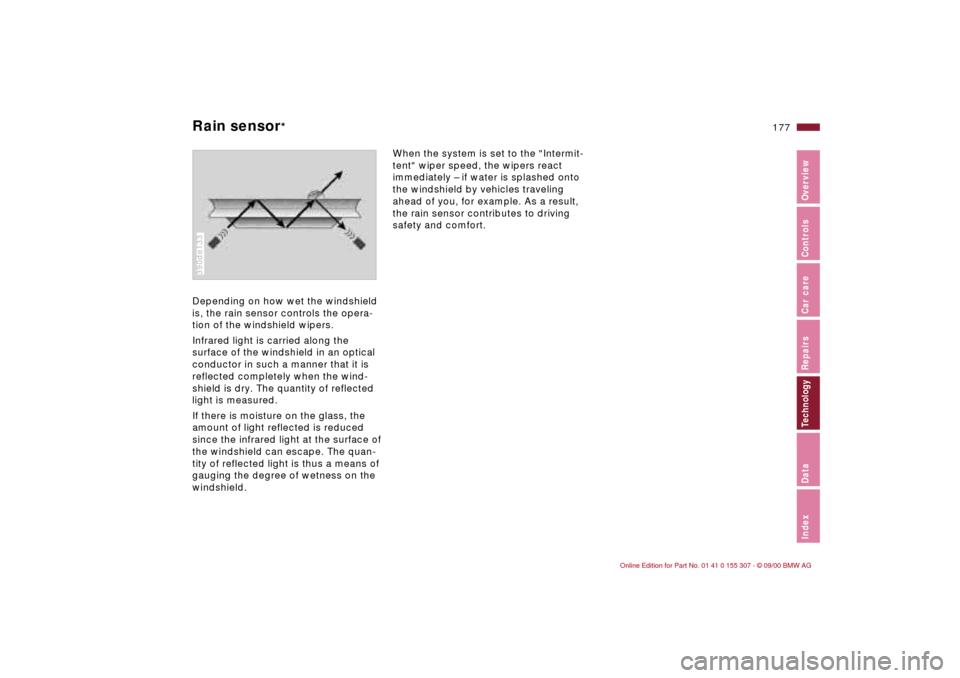
177n
IndexDataTechnologyRepairsCar careControlsOverview
Rain sensor
*
Depending on how wet the windshield
is, the rain sensor controls the opera-
tion of the windshield wipers.
Infrared light is carried along the
surface of the windshield in an optical
conductor in such a manner that it is
reflected completely when the wind-
shield is dry. The quantity of reflected
light is measured.
If there is moisture on the glass, the
amount of light reflected is reduced
since the infrared light at the surface of
the windshield can escape. The quan-
tity of reflected light is thus a means of
gauging the degree of wetness on the
windshield.390de133
When the system is set to the "Intermit-
tent" wiper speed, the wipers react
immediately Ð if water is splashed onto
the windshield by vehicles traveling
ahead of you, for example. As a result,
the rain sensor contributes to driving
safety and comfort.
Page 179 of 203
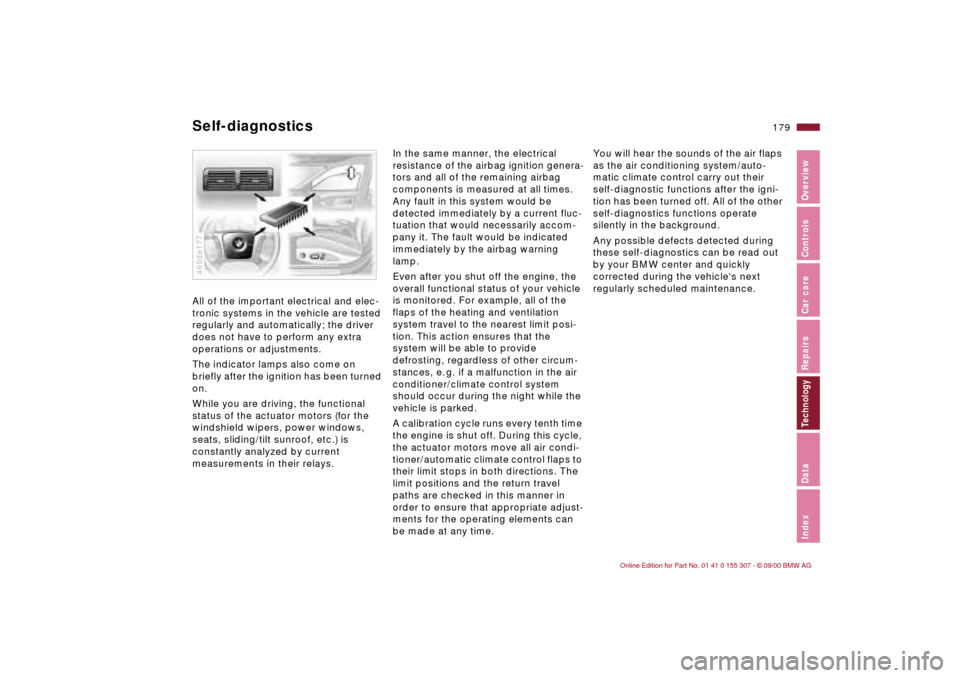
179n
IndexDataTechnologyRepairsCar careControlsOverview
Self-diagnostics All of the important electrical and elec-
tronic systems in the vehicle are tested
regularly and automatically; the driver
does not have to perform any extra
operations or adjustments.
The indicator lamps also come on
briefly after the ignition has been turned
on.
While you are driving, the functional
status of the actuator motors (for the
windshield wipers, power windows,
seats, sliding/tilt sunroof, etc.) is
constantly analyzed by current
measurements in their relays.460de177
In the same manner, the electrical
resistance of the airbag ignition genera-
tors and all of the remaining airbag
components is measured at all times.
Any fault in this system would be
detected immediately by a current fluc-
tuation that would necessarily accom-
pany it. The fault would be indicated
immediately by the airbag warning
lamp.
Even after you shut off the engine, the
overall functional status of your vehicle
is monitored. For example, all of the
flaps of the heating and ventilation
system travel to the nearest limit posi-
tion. This action ensures that the
system will be able to provide
defrosting, regardless of other circum-
stances, e. g. if a malfunction in the air
conditioner/climate control system
should occur during the night while the
vehicle is parked.
A calibration cycle runs every tenth time
the engine is shut off. During this cycle,
the actuator motors move all air condi-
tioner/automatic climate control flaps to
their limit stops in both directions. The
limit positions and the return travel
paths are checked in this manner in
order to ensure that appropriate adjust-
ments for the operating elements can
be made at any time.You will hear the sounds of the air flaps
as the air conditioning system/auto-
matic climate control carry out their
self-diagnostic functions after the igni-
tion has been turned off. All of the other
self-diagnostics functions operate
silently in the background.
Any possible defects detected during
these self-diagnostics can be read out
by your BMW center and quickly
corrected during the vehicle's next
regularly scheduled maintenance.